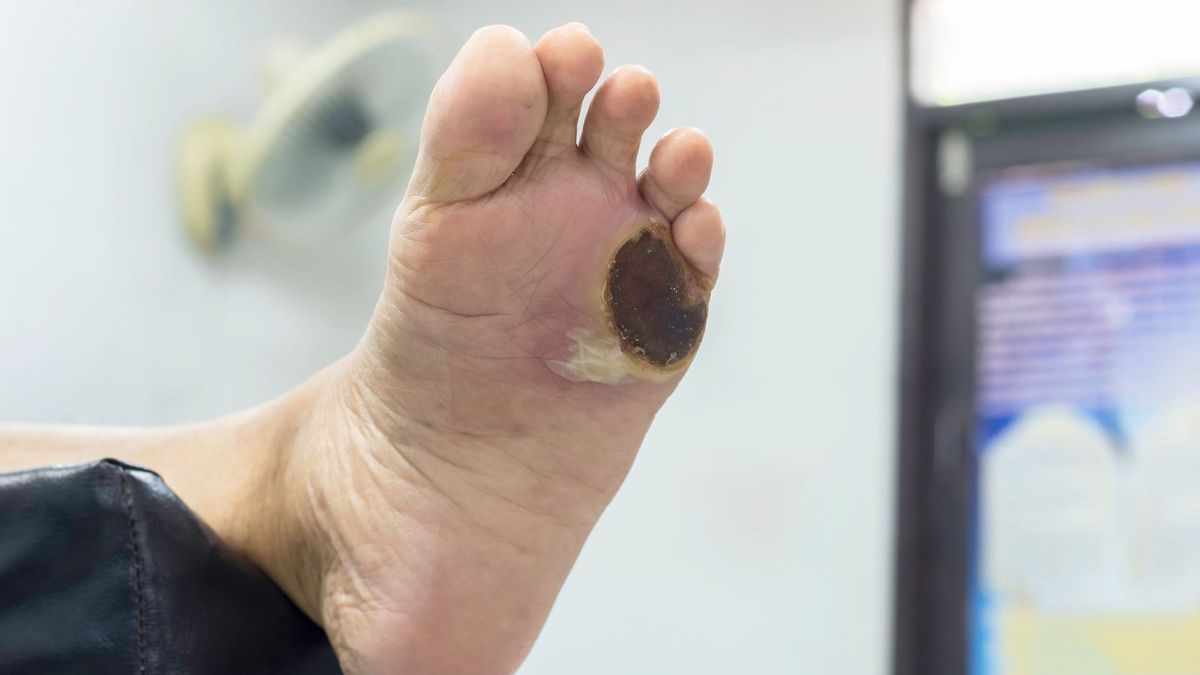
Published on
Updated
Necrosis is characterized by premature wear and death of cells. It can affect the skin, teeth, organs or even bones. What are the symptoms of necrosis? What are the causes and possible treatments? Update with Doctor Jean-Pierre Mercier, general practitioner.
What is necrosis?
“When a part of the human body is no longer vascularized by blood and oxygen, the tissues die. This is called necrosis.”, explains Doctor Jean-Pierre Mercier, general practitioner. There necrosis is a premature death of cells and tissues, caused by a lack of blood supply. Necrosis can be vascular, bone, dental or skin.
“One of the most common necroses is necrosis of the femoral head; the head of the femur is no longer vascularized. The installation of a hip prosthesis then proves essential”, indicates our specialist.
What is the difference with apoptosis?
The cells in our body are constantly renewing themselves. Some die when others are born and live: this is the cell regeneration, which is a natural phenomenon. During this process, cell death is normal and genetically programmed; It is apoptosis.
“When a command no longer works, in the case of a congenital or hereditary disease for example, the body is no longer able to regenerate tissues; it’s here necrosis”, indicates Dr. Mercier. In other words, the necrosis is a pathological cell death triggered by external factors (trauma, infections, etc.): it is abnormal.
What are the different types of necrosis?
There are many causes that can cause necrosis. This is why we distinguish them according to their etiology:
- The ischemic necrosis : a lack of blood circulation leads to a lack of oxygen supplied to the cells. “Arteritis of the lower limbs is the most concrete example. The arteries become blocked due to a circulatory deficit, blood no longer reaches the toes, the tissue dies and necrosis of the toe appears. Amputation then becomes obligatory if the surgeon cannot unblock the arteries.” ;
- The liquefaction necrosis : infections which are characterized by the formation of pus (mixture of cellular debris and degraded white blood cells), “such as, for example, the abscess occurring following a rosebush thorn sting. The pus travels inwards, the blood can no longer circulate. An abscess must be pierced, because if we do not pierce it, it forms necrosis of the skin” ;
Uncommon necroses are:
- The caseous necrosis : this is the typical necrosis of tuberculosis;
- The fibrinoid necrosis : necrosis within a blood vessel.
Symptoms: what are the signs of necrosis?
The symptoms of necrosis depend on its location:
- Skin necrosis : purplish skin, formation of blisters filled with brown liquid which can give off a foul odor. “Following a burn, for example, the skin turns black because the blood no longer reaches the vessels.”, adds the doctor. The cessation of vascularization leads to the absence of healing, causing a necrotic wound;
- Dental necrosis : occurs after a toothache, shock or infection. Pulpitis becomes chronic and the tooth gradually changes color, taking on a greenish or grayish tint, like that during a hematoma;
- Bone necrosis : pain, decreased range of motion and intermittent claudication if the leg is affected. “Necrosis of the femoral head, a common pathology, leads to the appearance of symptoms such as pain in the groin fold as well as painful mobility of the hip.” ;
- Organ necrosis : alteration of the functioning of the affected organ. For example, during a myocardial infarction, certain areas of the heart can become necrotic.
Causes: What causes necrosis?
Different causes can cause necrosis. It may be ischemia (circulatory deficit) causing a lack of oxygen supplied to the cells. For example, skin necrosis can be caused by a pressure sore, burn, or skin infection. And Doctor Mercier advises, “at the skin level, a wound that does not heal quickly with a disinfectant should be subject to increased monitoring and a consultation with your doctor.”.
Necrosis can also be caused by a tumor, severe trauma (burn, exposure to a chemical substance, radiation) or even a toxin (insect bite).
“Necrosis of the femoral head is caused by an old, or even very old, trauma, such as a fall. The femoral region tries to consolidate, but it is blocked by a lack of circulation in the arteries”explains our interlocutor.
What are the complications of necrosis?
The necrosis is not always dangerous for general health. The level of severity depends on the area affected by the necrosis. For example, when it affects the heart, it increases the risk of chronic heart failure. It can also be responsible for sepsis or gangrene.
Patients with diabetes are at risk of necrotic complications.
Diagnosis of necrosis
The diagnosis of skin necrosis is clinical. Otherwise, the doctor prescribes tests based on the symptoms. “For example, necrosis of the femoral head is visible through a radiological examination.. When it affects a tooth, a consultation with your dentist is essential.
Treatment: how to treat necrosis?
Treatment depends on the location of the necrosis as well as its cause.
Treatment of skin necrosis
Skin necrosis requires surgical intervention: excision of the necrotic flesh is necessary to ensure good tissue healing. Sometimes a skin graft is necessary. If a bacterial infection is the cause, antibiotic treatment will be administered to the patient intravenously.
Treatment of bone necrosis
Physiotherapy, painkillers and anti-inflammatory drugs are prescribed as first-line treatment in cases of osteonecrosis. In the most severe cases, amputation may be considered, particularly if the cartilage, bones or blood vessels are too damaged. “Necrosis of the femoral head may require the installation of a hip prosthesis, which gives excellent results.confesses our expert.
Treatment of dental necrosis
When the tooth is affected, the dentist carries out devitalization. He then suggests the installation of a dental crown.
